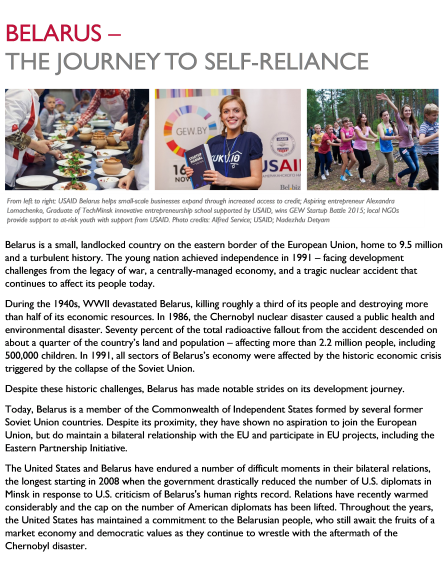Speeches Shim
Belarus is a small, landlocked country on the eastern border of the European Union, home to 9.5 million and a turbulent history. The young nation achieved independence in 1991 – facing development challenges from the legacy of war, a centrally-managed economy, and a tragic nuclear accident that continues to affect its people today.
During the 1940s, WWII devastated Belarus, killing roughly a third of its people and destroying more than half of its economic resources. In 1986, the Chernobyl nuclear disaster caused a public health and environmental disaster. Seventy percent of the total radioactive fallout from the accident descended on about a quarter of the country’s land and population – affecting more than 2.2 million people, including 500,000 children. In 1991, all sectors of Belarus’s economy were affected by the historic economic crisis triggered by the collapse of the Soviet Union.
Despite these historic challenges, Belarus has made notable strides on its development journey.
Today, Belarus is a member of the Commonwealth of Independent States formed by several former Soviet Union countries. Despite its proximity, they have shown no aspiration to join the European Union, but do maintain a bilateral relationship with the EU and participate in EU projects, including the Eastern Partnership Initiative.
The United States and Belarus have endured a number of difficult moments in their bilateral relations, the longest starting in 2008 when the government drastically reduced the number of U.S. diplomats in Minsk in response to U.S. criticism of Belarus's human rights record. Relations have recently warmed considerably and the cap on the number of American diplomats has been lifted. Throughout the years, the United States has maintained a commitment to the Belarusian people, who still await the fruits of a market economy and democratic values as they continue to wrestle with the aftermath of the Chernobyl disaster.
USAID began its support to Belarus in the mid 1990's. Over the years, USAID programs have prioritized promoting small-scale privatization, business education, and entrepreneurship support; developing democratic institutions; stimulating community development; and improving health and social services. Belarus has made notable progress towards self-reliance in this time, particularly in its efforts to improve the health of Belarusians and address issues that affect vulnerable populations.
USAID’s impact in Belarus likewise can be felt most tangibly by its most vulnerable populations.
Over the course of nearly a decade, USAID worked hand-in-hand with Child Find International (USA) to promote systemic changes for how Belarus cares for vulnerable children. This partnership helped Belarus to strengthen child welfare rights and overhaul its orphanages, ensuring that more children, including those with disabilities, grow up in safe, caring environments. A key focus has been reducing the number of children living in state-run institutions.
The outcome of these efforts cannot be understated.
USAID’s program left a legacy of local institutions able to carry forward training for educators and child welfare workers, informed by international best practices and grounded in the goal of keeping children out of institutions. The national rate of institutionalization of children in adversity continues to drop, decreasing from 29.4 percent in 2005 to 16.5 percent in 2014. In addition, ensuring that children with disabilities receive a quality education has also become a national priority, with the Belarusian government taking the lead. The Ministry of Education adopted a National Concept on Inclusive Education, aiming for full inclusivity by 2020.
Other programs build on this effort. USAID’s Community Connections activity, for example, has facilitated study tours to the United States for Belarusian professionals and specialists to gain first-hand exposure to American methodologies and best practices in championing inclusive education. Two participants from the University of Baranovichi leveraged their time in the United States to affect change at their own school, helping to embed inclusive education principles into the university’s teacher training curricula and into students’ activities. Today the University’s Inclusive Education Resource Center assists students with special needs, children with disabilities and their caregivers, lecturers, and future educators. As a nationwide professional development provider, the Center has already educated 400 local teachers on topics related to inclusive education.
And today, the Resource Center has greater self-reliance, carrying out all activities without donor support.
USAID has also partnered extensively with civil society organizations (CSOs) to support the rights of people with disabilities. One particular local CSO -- the Belarusian Association for Children and Young People with Disabilities (BelAPDIiMI) -- is a good example of these efforts. BelAPDIiMI is a membership-based organization that unites 3,500 families in its mission to provide children and young people with disabilities equal opportunities in all areas of life. Last fall, USAID Belarus and BelAPDIiMI launched a new initiative to create a fashion collection with direct participation of people with disabilities. Three Belarusian designers presented their collection at the 2018 Belarus Fashion Week (BFW) show, embroidered with indigenous birds and plants. Several young women with disabilities embroidered the collection and took part at the BFW show, thereby breaking down one more social and economic barrier.
Efforts by USAID and local CSO partners to promote inclusion and the rights of people with disabilities have generated national-level change. Belarus ratified the UN Convention on the Rights of Persons with Disabilities in 2016, with significant engagement and leadership from CSOs like BelAPDIIMI. The group’s efforts helped shape the National Plan on Implementing the Convention for the Rights of People with Disabilities and provided a platform for youth with disabilities to take part as young leaders and change makers.
These are only a few of the many examples of how USAID supports Belarus on its Journey to Self-Reliance. While there is some way to go, USAID is working in partnership with Belarusians to make the necessary strides toward meeting that vision.


Comment
Make a general inquiry or suggest an improvement.